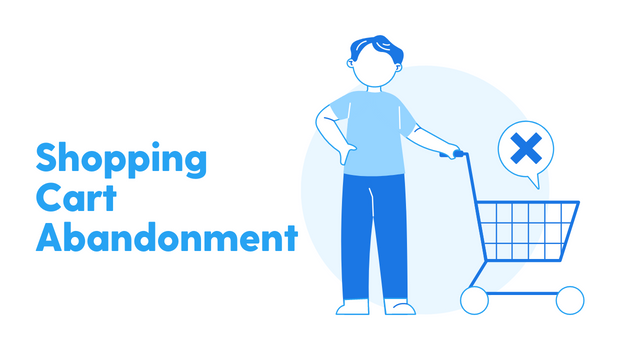Shopping cart abandonment is a common problem in eCommerce, where customers add items to their online shopping cart but do not complete the purchase. This results in a lost sale for the business and can significantly impact revenue.
It is important for businesses to address cart abandonment because it can lead to lost sales and lower conversion rates. Additionally, understanding the reasons behind cart abandonment can help businesses improve the customer experience, resulting in increased customer loyalty and repeat sales.
By identifying and addressing the root causes of cart abandonment, businesses can improve their bottom line and create a more positive customer experience.
Shopping Cart Abandonment Rate
The cart abandonment rate is a metric that measures the percentage of shoppers who add items to their online shopping cart, but then leave the website before completing the purchase.
Shopping cart abandonment rate is calculated by dividing the number of abandoned shopping carts by the total number of initiated checkouts.
For example, if 100 shoppers add items to their cart and 20 of them leave the website before completing the purchase, the shopping cart abandonment rate would be 20%.
Also, read:
Industry Averages on Cart Abandonment Rates
According to a study by Baymard Institute, the average shopping cart abandonment rate for eCommerce websites is around 69.57%. However, this can vary depending on the industry and type of product. For example, digital goods have a lower abandonment rate (around 60%) than physical goods (around 80%).
Another study by Barilliance, an eCommerce personalization platform, shows that the retail industry’s average shopping cart abandonment rate is 75.6%.
It’s worth noting that the abandonment rate can also vary depending on different factors, such as the website design, checkout process, and delivery options.
13 Reasons Why Shoppers Abandon their Cart
- Difficulty finding or accessing the cart
- Site navigation issues
- Technical difficulties such as website crashes or slow loading times.
- High Shipping Costs or lack of free shipping: High shipping costs can be a major deterrent for customers, as it can greatly increase the overall cost of their purchase.
- Hidden Fees: Unexpected fees, such as taxes or handling charges, can also cause customers to abandon their carts.
- Complicated Checkout Process: A long or complicated checkout process can be frustrating for customers and cause them to abandon their carts.
- Lack of Trust in the Brand: Customers may be hesitant to make a purchase if they don’t trust the brand or website. This can be due to a lack of customer reviews, inadequate return policies, or a lack of security measures.
- Comparison Shopping: Customers may abandon their carts to compare prices or products from other retailers.
- Unexpected Total Cost: Sometimes the total cost of an order may be higher than what a customer expected. This can be due to unexpected taxes, shipping costs, or conversion rates.
- No Guest Checkout: Requiring customers to create an account before making a purchase can be a deterrent for some, as it can be seen as an additional step in the checkout process.
- No Express Checkout: Some customers may prefer express checkout options like PayPal or Apple Pay, which can make the checkout process faster and more convenient.
- No or Limited Payment Options: Having a limited number of payment options can discourage customers from completing their purchase.
- Lack of Product Information: Sometimes, customers may abandon their carts if they feel they lack the information they need to make a purchase decision, such as detailed product descriptions, images or videos.
Also, read:</>
Abandoned Cart Recovery
Abandoned cart recovery is the process of reaching out to customers who have added items to their online shopping cart but have not completed the purchase. This is typically done through email campaigns, which aim to remind customers of the items in their cart and encourage them to complete the purchase.
Abandoned cart recovery is important for businesses because it can help to increase sales and revenue. According to industry statistics, the average cart abandonment rate is around 69.57%, which means that almost 7 out of 10 customers who add items to their cart do not complete the purchase. By reaching out to these customers through abandoned cart recovery emails, businesses can potentially recover a significant portion of these lost sales.
Additionally, abandoned cart recovery can also help to improve customer retention and loyalty by showing that the business values its customers and is willing to go the extra mile to help them complete their purchase. It also helps to reduce friction and make the purchase process more convenient for the customers.
Overall, abandoned cart recovery is an effective strategy for businesses to increase sales and improve customer engagement. It’s a cost-effective way to drive more revenue and improve customer loyalty.
6 Strategies for Abandoned Cart Recovery
- Cart abandonment email: This is the most common abandoned cart recovery strategy. A business will send an email to a customer who has added items to their cart but has not completed the purchase. The email may include a reminder of the items left in the cart, a special offer or promotion to incentivize the purchase, and a clear call to action to return to the website and complete the purchase.
- Retargeting ads: Another effective abandoned cart recovery strategy is to use retargeting ads. These ads are shown to customers who have visited your website and added items to their cart but did not complete the purchase. The ads can be displayed on different platforms such as Google, Facebook, Instagram, and other social media platforms. The ads can include the items left in the cart with a special offer or a reminder.
- Exit-intent pop-ups: This strategy captures the customer’s attention when they are about to leave the website. A pop-up window appears when a customer is about to close the website or navigate away from it. It usually has a special offer, or a reminder of the items left in the cart.
- Push notifications: With this strategy, a business can send push notifications to customers who have abandoned their cart. These notifications can be sent on the website or through a mobile app. They can remind customers of the items left in the cart and offer a special deal or promotion to incentivize the purchase.
- SMS Reminders: This strategy involves sending SMS messages to customers who have abandoned their cart. The message will remind them of the items left in their cart and offer a special deal or promotion to incentivize the purchase.
- Live chat: This strategy involves having a live chat support available on the website where customers can ask questions and seek assistance from a customer service representative. This can help address any concerns or questions that may prevent the customer from completing their purchase.
8 best Practices for Crafting High-Converting Cart Abandonment Emails
- Personalization: Use the customer’s name and include details about the items left in their cart to make the email feel more relevant to them.
- Urgency: Create a sense of urgency by including a limited time offer or highlighting that the items in the cart are running low on stock.
- Trust-building elements: Use customer reviews, testimonials, or trust badges to build confidence in your brand and the products in the cart.
- Clear call-to-action: Make it clear what the customer should do next, whether it’s returning to their cart to complete the purchase or taking advantage of a limited-time offer.
- Reminder of items left in the cart: Make sure the customer is reminded of the items they left in their cart, with images and descriptions of the products.
- Make it mobile-friendly: Make sure the email is optimized for mobile viewing as most of the customers will be viewing the email on their mobile.
- Timing: Send the first email within an hour of abandonment and the second email 24 hours later to reach the customer at the right time.
- Monitor and optimize: Continuously monitor and optimize the performance of your cart abandonment emails by testing different subject lines, offers, and other elements to see what works best.
Cart Abandonment Statistics
Cart abandonment rates vary by industry, with some industries having higher rates than others. According to a study by SaleCycle, the average cart abandonment rate across all industries is 69.57%.
| Industry | Cart Abandonment Rate |
| Travel and Hospitality | 75.6% |
| Events | 75.5% |
| Gaming | 75.4% |
| Electronics | 72.9% |
| Food and Beverage | 72.7% |
| Fashion | 72.2% |
| Home and Garden | 67.9% |
| Health and Beauty | 67.7% |
| Sports and Outdoors | 67.5% |
| Books and Media | 67.3% |
| DIY and Tools | 66.5% |
It’s also worth noting that mobile devices have higher cart abandonment rates than desktops, with an average of 85.65% compared to 67.91%.
These statistics are averages and can vary depending on the specific company or website. Additionally, these statistics may have changed since the study was conducted and should only be used as a reference point.
The data on cart abandonment rates provides valuable insights for businesses looking to reduce their own cart abandonment rates. Here are a few key takeaways:
- High shipping costs and lack of free shipping options are major reasons for cart abandonment. Businesses in the travel, events, gaming and electronics industries may want to consider offering free shipping or reducing shipping costs in order to reduce cart abandonment.
- Complicated or lengthy checkout processes are also a common reason for cart abandonment. Businesses should aim to simplify the checkout process as much as possible and ensure that it is easy to navigate and understand.
- Trust and transparency are important factors for online shoppers. Businesses should make sure to have clear return policies and easy-to-find contact information on their website to build trust with shoppers.
- Mobile devices have higher cart abandonment rates than desktops, indicating that businesses should optimize their mobile checkout experience.
- Businesses in certain industries, such as fashion, food and beverage, and electronics, may have higher cart abandonment rates on average. These businesses may want to pay extra attention to reducing cart abandonment.
- Businesses should also take note of the industry average and try to be better than the average to reduce their own cart abandonment rates.
It’s important to note that these are general insights and individual businesses may have different reasons for their own cart abandonment rates and should conduct their own research and analysis.
Also, read:
Cart Abandonment Solutions
Let’s outline and compare seven shopping cart abandonment solutions:
| Solution | Pros | Cons | Examples |
| Personalization | Increases customer engagement and sales | May be difficult to implement for businesses with a large customer base or limited data | Recommending products based on browsing or purchase history |
| Checkout optimization | Improves customer experience and increases conversions | May require technical expertise to implement | Streamlining checkout process, using one-page checkout, pre-filling customer information |
| Remarketing | Increases sales and customer engagement | May be seen as intrusive by some customers | Sending targeted email campaigns or retargeting ads to customers who have abandoned their cart |
| Abandoned cart recovery mail | Recover lost sales and increase revenue | May be seen as intrusive by some customers | Automated email or SMS that remind customers of the items left in their cart, with a direct link to complete the purchase |
| Free Shipping | Increases sales and customer loyalty | May be costly to implement, depending on the cost of shipping | Offering free shipping on orders above a certain threshold |
| Guest Checkout | Increases conversions and reduces cart abandonment | May lead to lack of customer data for remarketing and personalization | Offering guest checkout option |
| Live Chat or Phone Support | Helps build trust and customer loyalty | May require additional staff or resources to implement | Providing customers with the option to chat or speak with a representative during the checkout process |
Step-by-Step Guide on Using GA4 & GTM to Reduce Shopping Cart Abandonment
Set up GA4 on your website: Make sure you have GA4 installed on your website and that it is properly configured to track all necessary data.
Create a conversion event for abandoned carts: In the GA4 interface, set up a conversion event for when a user abandons their shopping cart. This will allow you to track the number of abandoned carts on your website.
Here is an example of how you can set up an abandoned cart conversion event in GA4 using GTM:
- Create a new tag in GTM: In the GTM interface, create a new tag for the abandoned cart conversion event. You can use the GA4 Event tracking template provided by GTM.
- Configure the tag: In the tag configuration, set the event category as “Ecommerce”, the event action as “Abandoned Cart,” and provide a unique label.
- Fire the tag: Set the trigger for the tag to fire when the user abandons the shopping cart. This can be done using a custom JavaScript code that detects when the user leaves the checkout page without completing the purchase.
- Publish the tag: Once it is set up and configured, publish it in GTM to track the abandoned cart conversion event.
- Test the tag: Add items to the cart and leave the checkout page without completing the purchase. Verify that the tag is firing correctly and the data is being sent to GA4.
Analyze the data: Look at the data in GA4 to understand when and why users are abandoning their shopping carts. Use the insights to identify patterns and areas for improvement.
Implement solutions: Based on your insights, implement solutions to reduce shopping cart abandonment. This could include things like offering discounts, simplifying the checkout process, or providing more detailed product information.
Test and monitor: Continuously test and monitor the solutions you’ve implemented to see if they are having a positive impact on reducing shopping cart abandonment. Use the data in GA4 to track the progress and make further improvements.
Repeat the process: Continuously analyze and improve the performance of your website to reduce the shopping cart abandonment rate and increase the conversion rate.
Also, read:
Conclusion
In conclusion, shopping cart abandonment is a major issue for online retailers, leading to lost sales and revenue. However, by properly implementing Google Analytics 4 (GA4) and Google Tag Manager (GTM), brands can gain valuable data on customer behavior and journey, leading to a better understanding of the reasons for cart abandonment. This can help businesses to take necessary actions to reduce cart abandonment and increase conversions, ultimately leading to lower customer acquisition costs and increased profitability.
Saras Analytics can help businesses achieve this by offering a free GA4 audit. Additionally, Saras can help businesses set up a customer data platform, providing a 360-degree view of the customer, and leading to even better insights and decision-making. If you want to improve your eCommerce performance, we invite you to contact us today to schedule your free GA4 audit or discuss your customer data platform needs.













